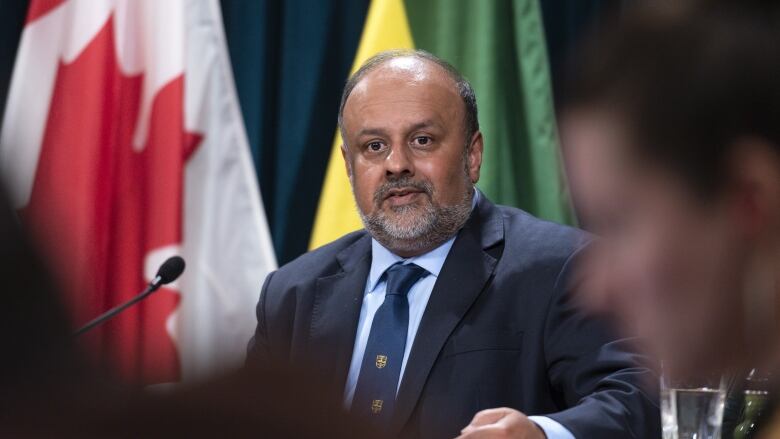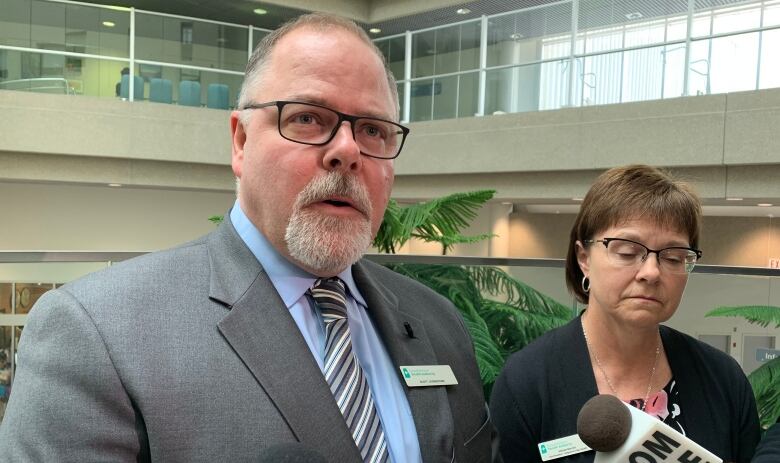COVID-19 in Sask: Top doc 'extremely happy' with low case numbers but says province needs to avoid 2nd wave
Decisions about loosening restrictions will need to be made 'on a week to week basis': Dr. Shahab

Click here for the latest:New travel-related cases slow to a standstill
- Saskatchewan has reported 301 cases of COVID-19, including 187 people who have recovered from the virus.
- Only one new case was recorded Tuesday, the lowest daily increase in weeks.
Saskatchewan's top public health doctor says the low number of newCOVID-19 in recent days cases makes him "extremely happy."
"Things are looking very positive," Dr. Saqib Shahab said on Tuesday, just after the province announced only one new infected person the lowest daily increase in cases in nearly one month.
But Shahab soon tempered his initialreaction by saying Saskatchewan must remain vigilant against a potentialsecond wave of cases.
"We have to realize that things can quickly surge back as many countries in Southeast Asia have seen," Shahab said.
Echoing comments made by Premier Scott Moe on Monday, Shahab said Saskatchewan will still need to conduct a high amount of COVID-19 testing in the weeks to come. An average of 750 tests were conducted daily last week. The goal is to double that averageby the end of the month, Moe has previously said.
Shahab said Saskatchewan also needs to actively monitor for potential outbreaks in places like long-term care centres, which have so far been spared by the novel coronavirus in Saskatchewan(although one workerat a Regina assisted living centrereportedly tested positive two weeks ago).
Recently, Meadow Lake and Prince Albert became the first communities outside of Saskatoon and Regina to begin on-site testing.
Here's how Saskatchewan's 301 COVID-19 cases break down regionally. The one new case announced Tuesday is in the region dubbed "North".

Timeline for lifting restrictions
Shahab said decisions on easing public health orders, which have especially hit businesses hard, would have to be looked at "on a week-to-week basis."
"[We must] also learn from other jurisdictions who are ahead of us in the curve," Shahab said, pointing out thatSaskatchewan wasfour to five weeks behind provinces like Quebec, Ontario and B.C. when its pandemic began.
"I think ultimately it's still up to all of us to stay the course for the next while," he said.
- COVID-19 in Sask: Province trims list of stores that can physically stay open
- A timeline of the measures Saskatchewan has taken to help flatten the curve in the province
On Monday, Moe said that if the number of new COVID-19 remains low, a plan on reviving parts of the province's economy could be released next week. Moe said "maybe a couple [more] weeks of steady numbers" would be needed to actually trigger any clawbacks on public health orders.
Moe said talk of "reopening" was "no reason for complacency" and "no magic switch" can be flipped to return life to normal in the province.
Here's a graph showing the virus' footprint in Saskatchewan over the past month.
NDP warns against early relaxing of measures
Opposition NDP Leader Ryan Meili said Saskatchewan should not relax measures too soon, a mistake he said was made by Canada when SARS hit Toronto in the spring of 2003.
"We are still very early in Saskatchewan's exposure to COVID-19," Meili said. "The risk is still very serious and it would be premature to start telling people it was time to stop physical distancing."
Meili said the province could "reverse" gains made by acting too quickly, being overconfident or having conversations that lead to people believing physical distancing is "less important."
1 month's supply of PPE
Shahab's comments Tuesday came during a news conference hosted by the Saskatchewan Health Authority (SHA), which gave an update onits supply of personal protective equipment (PPE) for front-line health care workers.
Scott Livingstone, the health authority's CEO, said hospitals and other care centres collectively have about a month's worth of PPE, with more on order.
The prices being demanded are higher than normal, Livingstone said.
"We would be ordering three to four times what we normally would,and unfortunately, we're not paying the same price as we would normally given the global issues around access to PPE," Livingstone said.

Livingstone agreed the recent dip in new Saskatchewan COVID-19 case numbers is "encouraging" but added, "we don't have a crystal ball, so we don't know what's going to happen next week."
Daily temperature checks
Earlier on Tuesday, the health authority said it was working toward having all of its health care workers be tested for a high temperature before and afterevery shift.
The latest precaution to safeguard workers and patients during the COVID-19 pandemicwas flagged Monday during a news conference by both Premier Scott Moe andScott Livingstone, the health authority's CEO.
"We are expanding this week health care worker screening across all of our facilities and our partner at the AthabascaHealth Authority," Livingstone said.
The screening will apply tolong-term care facilities, hospitals andprimary care sites.
An SHA memo sent to staff on Monday was slightly more explicit about what type of screening is involved and how broadly it will be applied.
"We are working toward a provincial standard of daily screening with temperature checks for the health care workforce (HCW) and continuous masking for patient-facing providers across the SHA and affiliates," according to the memo.
"All physicians, staff, volunteers, learners, trainees, vendors and contractors working on the site, regardless of role or patient/resident contact, will be screened to prevent the spread of COVID-19."
A phased-in approach
The screening won't begin for everyone all at once due availability of no-touch thermometers and "ensuring adequate human resources,"according to the memo.
"We anticipate screeningto be phased-in, starting with self-screening at a minimum and working toward screening stations with two-step temperature checks as soon as possible."
Some screening willkick in on Thursday.
Starting April 15, staff, physicians, learners, trainees, vendors & contractors will be screened daily as they enter any SHA area for symptoms of influenza-like illness. Staff & physicians in patient/client/resident care will wear masks at all times. More: https://t.co/PK7YM43xFV
—@SaskHealthDuring Monday's news conference,Moe said the temperature checks would happen both "pre- and post-shift."












_(720p).jpg)


 OFFICIAL HD MUSIC VIDEO.jpg)
.jpg)



























































































